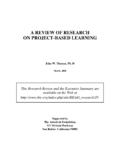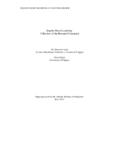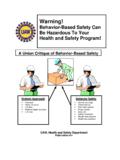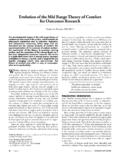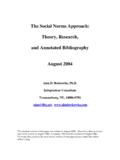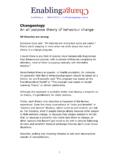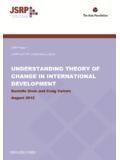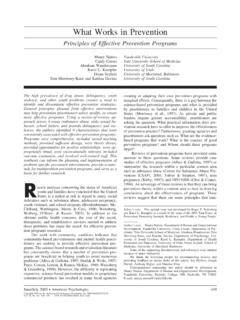Transcription of Mozart and Quantum Mechanics: An Appreciation …
1 Physics Today Volume 56, No. 2, 43-47 (February 2003) Mozart and Quantum Mechanics: An Appreciation of Victor WeisskopfWeisskopf had a rare and harmonious blend of sentiment and intellectual rigor. Heliked to say that his favorite occupations were Mozart and Quantum Gottfried and J. David JacksonFigure 1: Victor Weisskopf at about age 20 (photo courtesy of Duscha Scott Weisskopf)Victor Frederick Weisskopf, who died on 21 April 2002, was a leading figure in the secondgeneration of theoretical physicists who expanded the reach of Quantum mechanics followingits discovery in 1925-26. That discovery proved to be the most profound and swift turningpoint in the history of physics since the time of Isaac Newton. Born in Vienna on 19 September 1908, Viki, as he was called by all who knew him, was too young to do originalresearch in those first watershed years. But, like other outstanding members of hisremarkable cohort, Viki was a fast study.
2 He published his first landmark paper1 at the age was eventually to become a major actor in a wide variety of settings, but all these roleswere consequences of his achievements as a creative scientist. Therefore we devote hereconsiderable attention to his contributions to fundamental theoretical a teenager, Viki became fascinated with astronomy and proudly listed a paper on thePerseid showers, based on a night's observation when he was not yet 15, as his The rich artistic and intellectual ambiance of pre-Nazi Vienna was to deeplyinfluence his interests and attitudes throughout his Among his passions was music. Inhis youth, Viki became an accomplished pianist and even considered a career as aprofessional excellent lectures by Hans Thirring at the University of Vienna gave Viki his firstexposure to theoretical physics. But Vienna was not then at the forefront of research.
3 So hetook Thirring's advice and continued his studies at G 2: At his retirement celebration in 1974, Weisskopf conducted a chamber orchestra ina performance of Bach s Brandenburg Concerto No. 3. Earlier in the program he performedat the arrived in G ttingen, the mecca of Quantum mechanics , in 1928 and became a doctoralstudent of Max Born. By that time, nonrelativistic Quantum mechanics had alreadydemonstrated its power in atomic physics--so much so that Paul Dirac quipped that it wouldexplain all of chemistry and most of physics. In 1928, Dirac published his pivotal extensionof the Schr dinger wave equation to relativistic phenomena. The Dirac equation, incombination with Dirac's Quantum theory of the electromagnetic field, published the previousyear, gave birth to Quantum electrodynamics. Despite some striking early successes, QEDwas soon beset by deep technical and conceptual problems, which placed it at the veryfrontier of physics.
4 It would take half a dozen years to make QED understandable, and twodecades to develop it into a reliable theory. Viki was to play a large role in those natural width of spectral lines was the first unsolved problem that Viki attacked. Heproduced the solution himself for the case of energy levels that only decay to a stable stateand, in collaboration with Eugene Wigner, he extended the theory to all types of doctoral thesis in 1931 described the application of that theory to remarkable postdocIn the years 1931-37, Viki had the most remarkable of postdoctoral careers, first with WernerHeisenberg in Leipzig, then with Erwin Schr dinger in Berlin, Niels Bohr in Copenhagen,Wolfgang Pauli in Z rich, and then Bohr again. This history speaks not only to how Viki'stalents and promise were judged by the leaders of theoretical physics, but also to the scarcityof long-term positions during the Great Depression.
5 The job shortage was greatlyexacerbated for Viki by the exclusion of Jews from the relatively large number of academicposts in Germany after the Nazis came to power in January his postdoc period, Viki developed close friendships with many young colleagueswho were rapidly becoming prominent, especially Patrick Blackett, Felix Bloch, HendrikCasimir, Max Delbr ck, Rudolf Peierls, and George Placzek (see figure 4). And on Viki'ssecond day in Copenhagen, in 1932, he met Ellen Tvede, who was soon to be his wife. Ellenbecame his constant companion until her death in central problems of QED were the focus of Viki's research during this period: the roleof antiparticles and the self-energy of the electron. The negative-energy solutions of Dirac'srelativistic wave equation had, after some false starts, led Dirac in 1931 to propose that thosestates are filled by electrons in accordance with the Pauli exclusion principle, and that anyunfilled states, or holes, would appear as positively charged particles with the mass of theelectron.
6 Such particles were, in fact, discovered in cosmic ray experiments the followingyear, but whether they were indeed Dirac's anti-electrons was questioned by no less thanBohr and Pauli. Furthermore, when QED was applied to the self-energy problem, it producedterribly divergent 3: Professor Max Born (right) and fellow student Maria Goeppert with Weisskopf inG ttingen, circa understanding of both these problems was greatly advanced in two papers Viki wroteduring his two years as Pauli's assistent in Z rich. At Pauli's suggestion, he used hole theoryto do a perturbative calculation of the electron's self-energy. Viki made a sign error, whichwas quickly pointed out by Wendell Furry. When that correction was taken into account, theresult was a self-energy that diverges logarithmically as the electron's radius tends to was an astonishing result. Classical electrodynamics was long known to produce a lineardivergence, and QED had recently been shown to yield a quadratically divergent self-energyif the Dirac equation is taken to be the description of a one-particle system.
7 But Viki wasdisheartened by having made the error in the calculation; it aggravated his lack ofmathematical self-confidence. This insecurity was to plague him again later, in hiscalculation of the Lamb second Z rich paper, written with Pauli, dealt with the quantization of scalar Atthe time, this work was viewed as a purely theoretical exercise, because no "elementary"spin-zero particle was known. It was, however, an exercise that taught an important lesson,because it demonstrated that antiparticles are not a peculiarity of Dirac's theory for spin-1/2fermions. They are also an inevitable feature of a Quantum field theory of charged , the Pauli- Weisskopf paper demonstrated that a marriage of relativity andquantum mechanics does not require spin 1/2, as many physicists had incorrectly inferredfrom Dirac's theory. And with the advent of Hideki Yukawa's meson theory of nuclearforces, the scalar field theory became more than a setting-up exercise for 1936, during his second stay in Copenhagen, Viki published a classic paper on vacuumpolarization by a uniform electromagnetic field of arbitrary Although the topic hadalready been studied, the earlier work was very formal and marked by ambiguities.
8 Thisinvestigation, the technically most sophisticated of Viki's career, largely cleared up theseambiguities. Especially noteworthy was his prescient recognition of charge exploited the analogy with a charge placed in a polarizable medium to conclude thatvacuum polarization produces an unobservable constant (though infinite) factor thatmultiplies all charges and electromagnetic field awayBy 1936, it had become clear to Viki that an Austrian Jew had better leave Europe,preferably for the US. But that was far easier said than done. There were hardly any positionsavailable in the US, or elsewhere for that matter, and many outstanding physicists whoanticipated a Nazi onslaught were competing for them. To further his chances, Viki decidedthat he should publish something on nuclear physics--the new rage--and do it in English. Hecarried this off brilliantly with an original application of statistical mechanics to theevaporation of neutrons from nuclei, and published his results in the Physical 's first opportunities to leave came from the Soviet Union: a professorship in Kiev and asenior research position in Moscow.
9 In late 1936 he and Ellen visited Russia and promptlyrealized that the political climate there had deteriorated drastically since his earlier visit. Hewould, therefore, only consider a position in the USSR if nothing else was available. In thoseyears, Bohr went regularly to England and America to "sell" the refugees in his institute. In1937, Bohr convinced the University of Rochester to offer Viki a poorly paid instructorship,which he 4: Werner Heisenberg and prot g s at Leipzig University in 1931. In front are (left toright) George Placzek, Rudolf Peierls, and Heisenberg. In the back are Giovanni Gentile,Gian Carlo Wick, Felix Bloch, Weisskopf, and Fritz Viki arrived in Rochester, nuclear physics became a major focus of his research. Hisstudies of Coulomb excitation9 and radiative transitions10 were especially noteworthy. Healso continued to work on QED and published a remarkable paper addressing the electronself-energy problem in greater detail.
10 Particularly significant was his proof that the self-energy diverges logarithmically to all orders in perturbation This paper strengthenedhis 1934 fission was discovered in Berlin in December 1938, and, nine months later, Germanyinvaded Poland. Nuclear physics was suddenly transformed from an esoteric intellectualpursuit into a potentially decisive factor in the war. Not being a US citizen--indeed an"enemy alien" until 1943--Viki could not participate in secret war-related work until RobertOppenheimer asked him to come to Los Alamos in early the time, no experimental data were available for many of the processes involved in anuclear explosion or the ensuing effects. The Manhattan Project had to rely on theorists forguidance on many fronts. Viki became a prominent member of the theoretical-physicsdivision. In recognition of his ability to quickly devise qualitative solutions to physicsproblems, Viki's office became known as "the seat of the oracle.
